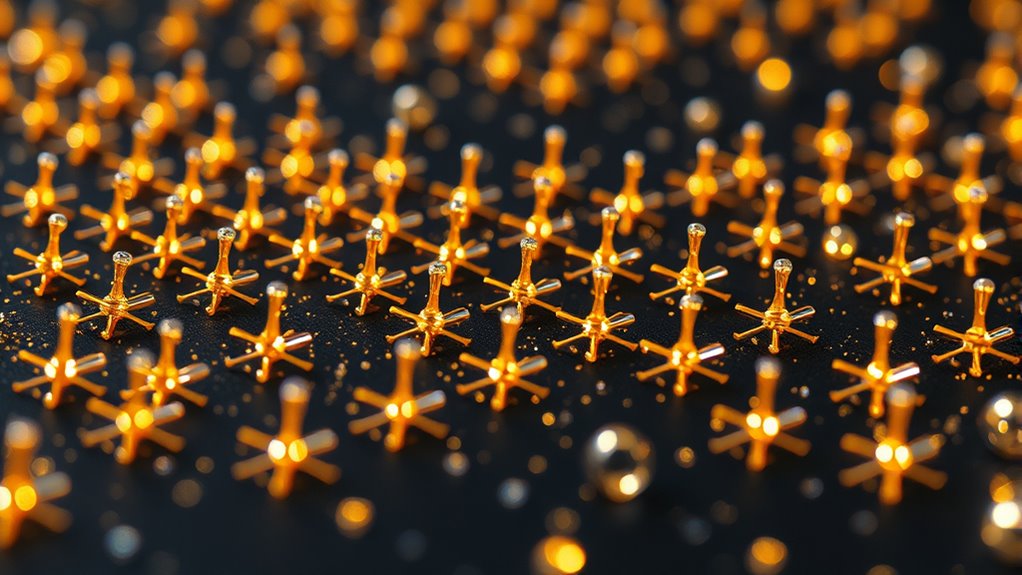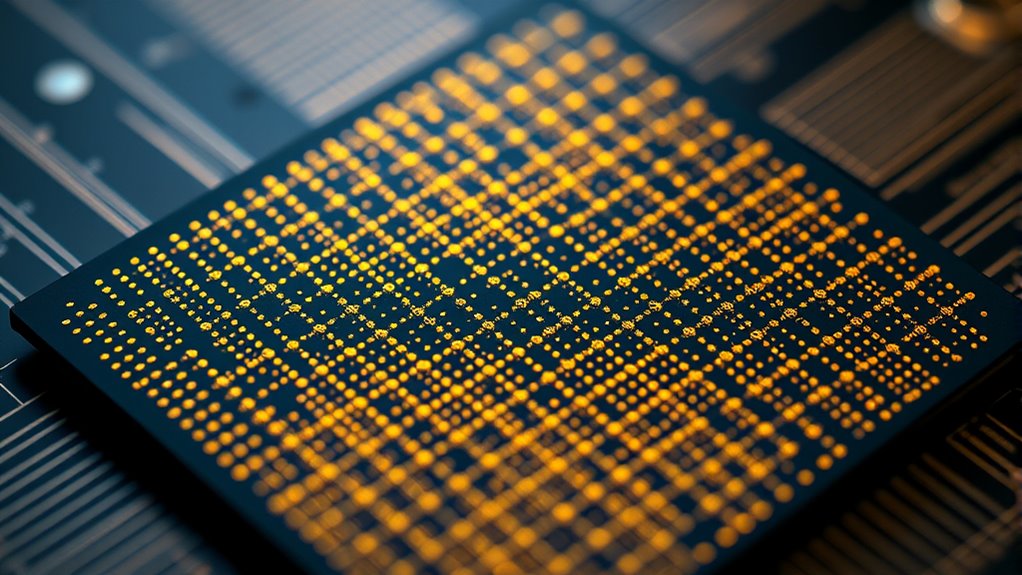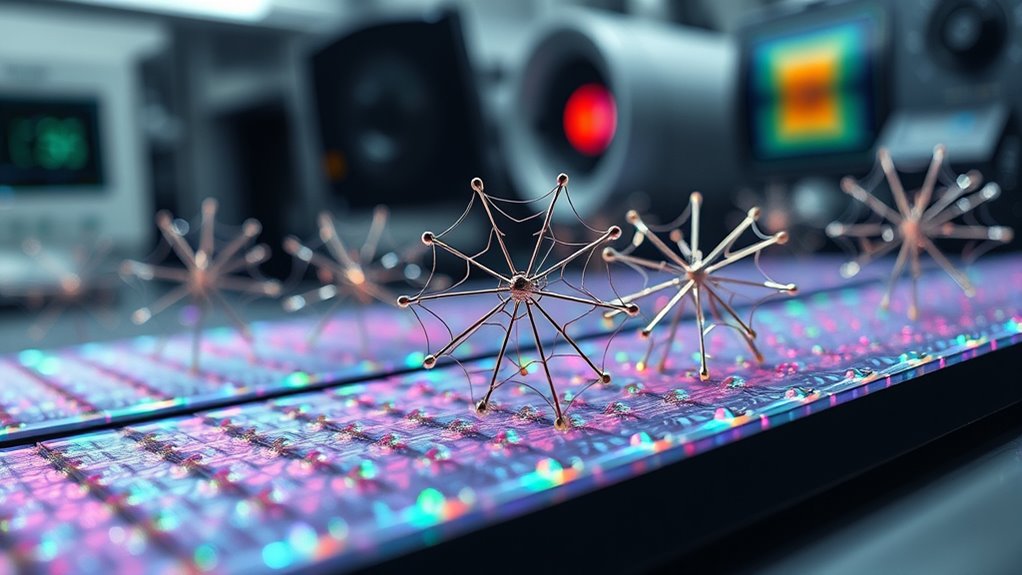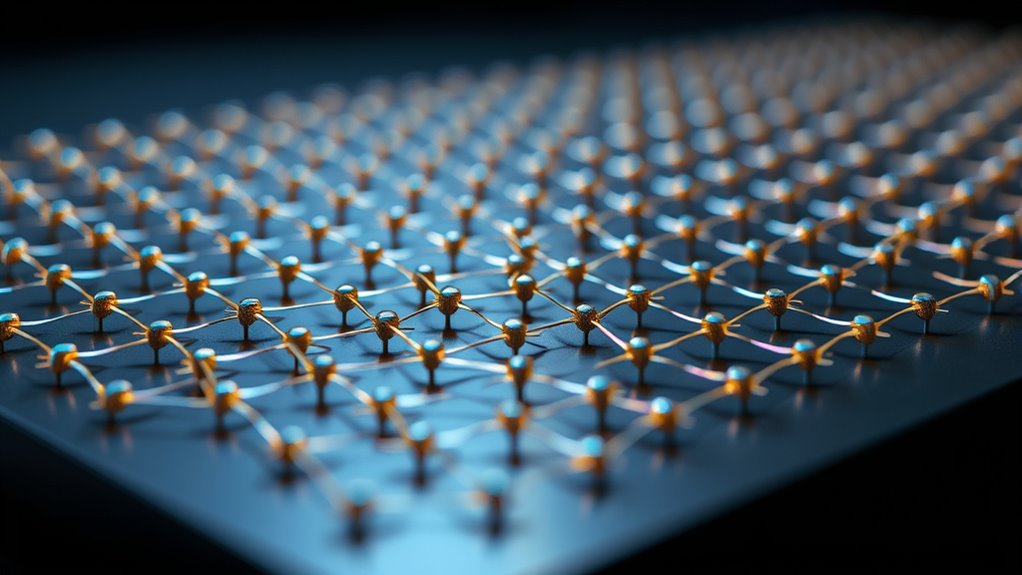Nanoantennas and metamaterials let you precisely control electromagnetic responses at tiny scales by tuning their structure, shape, and materials. They exploit phenomena like resonance, scattering, and quantum effects to achieve unique properties such as negative refraction and cloaking. These advancements enable improvements in imaging, sensing, wireless communication, and energy harvesting. If you keep exploring, you’ll discover how ongoing innovations are shaping the future of nanoscale electromagnetic engineering.
Key Takeaways
- Designing nanoantennas and metamaterials involves tuning size, shape, and material properties to achieve desired resonant electromagnetic responses.
- Fabrication techniques like lithography and material deposition enable precise structural engineering for tailored electromagnetic behavior.
- Manipulating plasmonic resonances, scattering, and quantum effects enhances light-matter interactions at the nanoscale.
- Structural arrangement and material selection influence properties such as negative refraction, cloaking, and superlensing.
- Incorporating active and multifunctional materials allows dynamic control and reconfigurability of electromagnetic responses.
Fundamentals of Nanoantennas and Their Design Principles

Have you ever wondered how tiny antennas can manipulate light at the nanoscale? Nanoantennas rely on principles like quantum coherence to enhance their interaction with electromagnetic waves, allowing precise control over light emission and absorption. Their design involves tuning size, shape, and material to resonate at specific frequencies, which maximizes efficiency. Managing heat is essential because these structures can generate significant thermal energy during operation, so effective thermal management guarantees stability and performance. Understanding the fundamentals of their design helps you optimize their electromagnetic response, whether for sensing, imaging, or energy applications. Efficient thermal management is crucial to prevent performance degradation caused by heat buildup. By harnessing quantum effects, nanoantennas can achieve unprecedented control over light, making them indispensable components in advanced nanophotonics.
Unique Properties of Metamaterials and Their Composition

Building on the principles behind nanoantennas, metamaterials stand out because of their ability to exhibit properties not found in natural materials. Their unique electromagnetic properties arise from carefully engineered metamaterial composition, which involves arranging subwavelength structures to manipulate waves precisely. You can achieve negative refractive index, cloaking effects, or superlensing by tailoring these structures. Unlike natural materials, metamaterials can respond to electromagnetic fields in unconventional ways, enabling control over wave propagation, absorption, and scattering. This customization stems from the specific geometry, size, and arrangement of their constituents. Additionally, self-awareness of their design parameters allows for even more precise control over their electromagnetic responses. As a result, they open new avenues for advanced applications in imaging, sensing, and communications, transforming how you engineer electromagnetic responses at the nanoscale.
Fabrication Techniques for Nanoscale Structures

To create nanoscale structures for nanoantennas and metamaterials, you need to choose appropriate lithography methods that offer precision and scalability. Material deposition techniques, such as sputtering or atomic layer deposition, are essential for achieving the desired layer quality. Additionally, nanoscale patterning strategies like electron-beam lithography or nanoimprint lithography enable you to define intricate designs with high accuracy.
Lithography Methods Selection
Selecting the appropriate lithography method is crucial when fabricating nanoscale structures for nanoantennas and metamaterials, as it directly impacts resolution, precision, and overall device performance. Your choice influences nanofabrication challenges and determines achievable lithography resolution. To choose effectively, consider these key factors:
- Resolution Needs: Determine if sub-10 nm features are necessary for your design.
- Throughput Requirements: Balance speed against detail; some methods are slower but more precise.
- Material Compatibility: ensure compatibility with your substrate and materials to prevent defects.
Material Deposition Techniques
Material deposition techniques are indispensable for fabricating nanoscale structures in nanoantennas and metamaterials, as they determine the quality, uniformity, and functionality of the final device. You can use methods like chemical vapor deposition, physical vapor deposition, or atomic layer deposition to achieve precise control over material thickness and composition. Self-assembly techniques also play a pivotal role, enabling you to form ordered nanostructures without complex patterning. After deposition, material characterization methods such as electron microscopy and spectroscopic analysis help you verify layer quality, interface integrity, and uniformity. These techniques guarantee your nanoscale structures meet the required specifications, directly influencing their electromagnetic responses. Mastering both deposition and characterization is essential for producing reliable, high-performance nanoantennas and metamaterials.
Nanoscale Patterning Strategies
Nanoscale patterning strategies are essential for creating the intricate structures required in nanoantennas and metamaterials. These techniques enable you to control features at the atomic level, influencing phenomena like quantum tunneling and surface plasmons.
- Electron-beam lithography allows precise patterning by scanning a focused electron beam, essential for defining nanoscale gaps where quantum tunneling occurs.
- Nanoimprint lithography uses molds to stamp patterns onto surfaces, enabling large-area fabrication of plasmonic structures that enhance surface plasmon resonance.
- Focused ion beam milling directly etches nanoscale features, giving you fine control over complex geometries critical for manipulating electromagnetic responses at the nanoscale.
Mastering these strategies helps optimize electromagnetic responses, ensuring your designs effectively harness quantum tunneling effects and surface plasmon interactions.
Manipulating Light at the Nanoscale: Resonance and Scattering

Understanding how light interacts with nanoantennas and metamaterials hinges on the concepts of resonance and scattering. By tuning plasmonic properties, you can control optical resonances to enhance or suppress specific wavelengths. When light hits these nanostructures, it excites collective electron oscillations, creating strong local fields. This plasmonic tuning allows you to manipulate scattering behavior, directing energy where you want it. Resonances amplify light-matter interactions, making nanoantennas highly responsive. As a result, you can tailor scattering patterns for sensing, imaging, or signal enhancement. Mastering resonance and scattering at the nanoscale enables precise control over electromagnetic responses, empowering you to design devices with customized optical properties. Incorporating textured fabrics and other natural elements can further enhance the interaction with light, creating more dynamic and responsive nanostructures. This understanding forms the foundation for advanced applications in nanophotonics and metamaterials.
Achieving Negative Refractive Indices and Cloaking Effects

By harnessing the principles of resonance and scattering in nanoantennas and metamaterials, you can engineer structures with negative refractive indices, enabling cloaking effects. Quantum tunneling allows electromagnetic waves to pass through ultra-thin barriers, enhancing negative index behavior. Plasmonic coupling between nanoantennas amplifies these effects by creating strong localized fields. To visualize this:
Harnessing resonance, tunneling, and plasmonic coupling enables cloaking through negative refractive index metamaterials.
- You design layered metamaterials with carefully tuned resonances.
- Quantum tunneling facilitates unusual wave propagation, bending light backwards.
- Strong plasmonic coupling leads to negative refraction, making objects invisible to specific wavelengths.
Additionally, understanding the diverse designs available for nanoantennas and metamaterials helps optimize their electromagnetic responses.
These mechanisms work together to manipulate electromagnetic responses, opening pathways to cloaking devices that guide light around objects seamlessly.
Enhancing Light-Matter Interactions for Sensing Applications

Have you ever wondered how tiny structures can dramatically boost the sensitivity of optical sensors? It all comes down to enhancing light-matter interactions through plasmonic coupling. When nanoantennas are closely spaced, their localized surface plasmons interact strongly, creating intense electromagnetic fields that amplify signals from nearby molecules. However, as distances shrink further, quantum tunneling can occur, allowing electrons to pass between particles. This tunneling can modify plasmonic behavior, sometimes reducing field enhancement but offering new sensing mechanisms. By carefully designing nanoantennas to optimize plasmonic coupling and control quantum tunneling effects, you can create sensors with higher sensitivity and selectivity. This precise manipulation of electromagnetic responses enables detection of minute quantities of analytes, revolutionizing sensing technology. Additionally, understanding the role of limits in design can inspire innovative approaches to overcoming physical constraints and achieving optimal performance.
Applications in Imaging and Medical Diagnostics

Ever wondered how nanoantennas and metamaterials are transforming medical imaging and diagnostics? They enable groundbreaking advancements by enhancing sensitivity and resolution. For example:
Nanoantennas and metamaterials are revolutionizing medical imaging with enhanced sensitivity and resolution.
- They improve imaging techniques through quantum entanglement, allowing you to detect minute biological changes with higher accuracy.
- Metamaterials boost the capabilities of gravitational wave detection, which can be adapted for ultra-sensitive diagnostic tools.
- Nanoantennas facilitate targeted imaging at the cellular level, making early disease detection faster and more precise.
- The integration of AI in nanotechnology is further optimizing device performance, leading to smarter and more efficient diagnostic solutions.
These innovations open new possibilities for non-invasive diagnostics and real-time monitoring. By manipulating electromagnetic responses at nanoscale, you gain deeper insights into biological processes, leading to better patient outcomes. This fusion of nanotechnology and physics is redefining the future of medical imaging.
Advancements in Wireless Communication Technologies

Advancements in wireless communication technologies are transforming how you connect, with improved signal transmission and more reliable networks. Miniaturized antenna designs enable your devices to become smaller and more efficient, opening new possibilities for compact gadgets. As 5G and beyond approach, these innovations will drive faster speeds and lower latency for your everyday activities. Additionally, the integration of advanced sound design techniques in device manufacturing can enhance user experience through improved audio clarity and immersive sound quality.
Enhanced Signal Transmission
How are researchers boosting wireless communication to meet the growing demand for faster, more reliable signals? They’re leveraging nanoantennas and metamaterials to enhance signal transmission efficiency. These innovations increase thermal conductivity, preventing overheating during high-frequency operations. They also utilize quantum entanglement to enable secure, instantaneous data sharing over long distances. Here are three ways this is achieved:
- Nanoantennas focus electromagnetic waves more precisely, reducing signal loss.
- Metamaterials manipulate wave propagation, increasing bandwidth and speed.
- Quantum entanglement creates ultra-secure links resistant to interference.
Together, these advancements push wireless tech forward, ensuring faster, more reliable connections for the future.
Miniaturized Antenna Designs
Building on the improvements in signal transmission efficiency, researchers are focusing on creating smaller, more versatile antennas that fit into increasingly compact devices. Miniaturized antenna designs leverage quantum effects to improve performance at tiny scales, enabling better signal reception despite reduced size. These designs often incorporate advanced materials, such as metamaterials, to manipulate electromagnetic responses precisely. Thermal management becomes critical as smaller antennas tend to generate heat more rapidly, risking performance loss or damage. Innovative cooling techniques and materials help dissipate heat effectively, maintaining antenna stability. By optimizing quantum effects and thermal management, you can develop ultra-compact antennas that deliver high efficiency, robustness, and adaptability for next-generation wireless devices, supporting the ongoing trend toward miniaturization without sacrificing performance.
Future 5G and Beyond
The evolution of wireless communication is rapidly transforming how we connect, with 5G technology leading the way toward unprecedented speed, capacity, and reliability. Looking ahead, future 5G and beyond will leverage breakthroughs like quantum entanglement to enable instant data transfer across vast distances. Topological insulators will play a critical role in developing ultra-efficient, robust antennas that resist interference. Here’s what you can expect:
- Quantum entanglement will enable secure, instantaneous communication, revolutionizing data privacy.
- Topological insulators will facilitate low-loss, high-performance nanoantennas, improving signal strength and energy efficiency.
- Integration of nanoantennas with metamaterials will liberate new frequencies and functionalities, paving the way for smarter, more adaptable networks.
These advancements will redefine connectivity, making future communication faster, more secure, and more reliable.
Energy Harvesting and Photovoltaic Integration

Energy harvesting and photovoltaic integration are transforming how you capture and utilize solar energy at the nanoscale. Nanoantennas enhance light absorption, making quantum dots more effective for energy conversion. These tiny structures can concentrate electromagnetic fields, increasing the efficiency of quantum dot-based solar cells. By integrating metamaterials, you can tailor the optical properties to better match the solar spectrum, boosting overall energy harvesting performance. This approach allows for flexible, lightweight, and highly efficient photovoltaic devices that can be embedded into various surfaces. As a result, you gain the ability to turn ambient sunlight into usable electrical energy more efficiently than traditional methods. Creating efficient nanoscale devices this integration of nanoantennas, quantum dots, and metamaterials opens new pathways for sustainable energy solutions at the microscopic level.
Future Directions and Emerging Trends in Nanoscale Electromagnetic Engineering

Advancements in nanoscale electromagnetic engineering are opening new frontiers for manipulating light and sound at unprecedented levels. You’ll see emerging trends focus on harnessing quantum coherence to enhance device performance and enable quantum information processing. Thermal management becomes increasingly critical as nanoscale devices generate heat; innovative cooling techniques will ensure stability and efficiency. Additionally, future research will explore integrating nanoantennas with metamaterials to achieve dynamic tunability and multifunctionality. Effective thermal regulation will be key to maintaining performance and extending the lifespan of these intricate nanosystems.
Frequently Asked Questions
How Do Nanoantennas Improve Energy Transfer Efficiency?
You can improve energy transfer efficiency with nanoantennas by leveraging plasmonic coupling, which concentrates electromagnetic energy into tiny regions, boosting signal strength. They also enable directional emission, meaning you can direct energy precisely where it’s needed, reducing losses. This combination guarantees more efficient energy transfer, especially at nanoscale, making nanoantennas highly effective for applications like sensing, communication, and energy harvesting.
What Are the Environmental Impacts of Fabricating Metamaterials?
Imagine building a delicate, intricate sculpture—metamaterials—using tiny, precise tools. During fabrication, you might generate waste and consume energy, impacting the environment. These processes can leave a notable environmental footprint, but sustainable manufacturing techniques aim to minimize this, reducing pollution and resource use. By choosing eco-friendly methods, you help protect ecosystems and promote responsible innovation, ensuring the environmental impacts of creating metamaterials stay as small as possible.
Can Nanoantennas Be Used in Quantum Computing?
Yes, you can use nanoantennas in quantum computing. They help with photon manipulation, which is vital for transmitting quantum information. Nanoantennas enable precise control over quantum entanglement, allowing you to enhance communication between qubits. By focusing and directing photons efficiently, they improve the stability and scalability of quantum systems, making nanoantennas a promising component in developing advanced quantum computers.
How Do Temperature Variations Affect Metamaterial Performance?
Imagine a delicate spiderweb trembling in the breeze—that’s how temperature variations can impact metamaterials. When temperatures change, they affect thermal stability and cause shifts in electromagnetic responses. You might use temperature tuning to adapt their properties, but extreme fluctuations can distort their performance. Keeping a stable environment guarantees your metamaterials maintain their desired behavior, allowing you to harness their full potential without losing control amid thermal chaos.
Are There Biocompatible Materials for Medical Nanoantenna Applications?
Yes, you can find biocompatible materials for medical nanoantenna applications. You should consider using biocompatible coatings like silica, gold, or polymers such as PEG, which guarantee safety and minimize immune responses. These materials enhance the performance of nanoantennas in medical imaging, allowing you to achieve better sensitivity and specificity. By selecting the right biocompatible materials, you’ll improve both the effectiveness and safety of your medical nanoantenna devices.
Conclusion
As you explore the world of nanoantennas and metamaterials, it’s clear how they’re transforming technology and opening new horizons. With ongoing innovations, you might wonder—are we on the brink of a future where manipulating light and electromagnetic responses becomes limitless? Embrace the possibilities, because your role in this exciting field could shape revolutionary advances in imaging, communication, and energy solutions. The future is in your hands—are you ready to make it extraordinary?









